A Scientometric Analysis Review on Agricultural Wastes Used as Building Materials
Abstract
1. Introduction
2. Methodology
Data Acquisition
3. Discussion
3.1. Trends in Scientific Study on Agricultural Wastes Used as Building Materials
3.2. Analysis of Research Keywords
3.3. Analysis of Articles’ Sources
- Cluster 1: Chemosphere links are identified to be 6, with total link strength of 10; Construction and Building Materials links are 14, with total link strength of 293; Journal of Environmental Management links are 12, with total link strength of 92; Key Engineering Materials links are 2, with total link strength of 2; Transactions of The Chinese Society of Agricultural Engineering links are 3, with total link strength of 3.
- Cluster 2: Applied Mechanics and Materials links are 6, with total link strength of 15; Environmental Science and Pollution Research links are 11, with total link strength of 113; Journal of Building Engineering links are 13, with total link strength of 296; Waste Management links are 7, with total link strength of 37.
- Cluster 3: Energy and Buildings links are 11, with total link strength of 202; Industrial Crops and Products links are 10, with total link strength of 96; Lecture Notes in Civil Engineering links are 7, with total link strength of 13; Sustainability (Switzerland) links are 10, with total link strength of 141.
- Cluster 4: International Multidisciplinary Scientific Geoconference Surveying Geology and Mining Ecology Management links are 7, with total link strength of 17; Materials links are 13, with total link strength of 156; Resources, Conservation and Recycling links are 8, with total link strength of 30.
3.4. Analysis of Articles’ Regions
- The clustered links for Brazil, Spain, the United Kingdom, and the United States are 12 and the total link strength is 4353. This cluster collection has the most considerable number of articles (143 articles).
- The clustered links for China, India, and Malaysia are 12 and the total link strength is 5237. This cluster collection has the most considerable number of articles (176 articles).
- The clustered links for Germany, Russian Federation, and Thailand are 12 and the total link strength is 2395. This cluster collection has the most considerable number of articles (73 articles).
- The clustered links for France, Italy, and Turkey are 12 and the total link strength is 4961. This cluster collection has the most considerable number of articles (86 articles).
4. Description of Active Research Areas: Agricultural Wastes Used as Building Materials
4.1. Agricultural Wastes Used in Concrete
4.2. Agricultural Wastes Used in Insulation
4.3. Agricultural Wastes Used in Thermal Insulating Materials
4.4. Agricultural Wastes Used in Mortar
4.5. Physical and Chemical Properties of Agricultural Waste Ash
4.6. Microstructural Characteristics of Agricultural Waste Ash
4.7. Mechanical Properties of Agricultural Waste Used in Building Materials
4.8. Research Trends and Recommendations
5. Discussion
6. Application
7. Conclusions
- In addition to Scopus, bibliometrics was utilized to compile this review’s findings. A total of 671 publications with the keywords “agricultural wastes used as building materials”, “agricultural wastes used as a replacement of cement”, and “agricultural wastes used as a replacement of aggregate” were found and investigated.
- It was found that the journals of Building and Environment, Energy and Buildings, Journal of Cleaner Production, and Construction and Building Materials have all published research works in the field of agricultural wastes used as building materials. There was consensus that Renewable and Sustainable Energy Reviews held the most sway.
- The research communities in China, India, and Australia have all made significant contributions, and there are many active links between them. India had a considerable yearly impact.
- Qualitative analysis summarized the major areas of research on agricultural wastes used as building materials and discussed existing gaps. This comprehensive review adds knowledge to the framework and direction for future research on this topic.
- With the help of this study, researchers can identify high-impact journals or scholars, understand recent trends in research on agricultural wastes as building materials, and promote academics and related works to think creatively about incorporating new agricultural wastes as building materials.
8. Recommendations for Future Research Work
- Limited research works have been published on the use of agricultural wastes as fine aggregate in concrete. This allows for a thorough examination of the engineering characteristics of every agricultural-waste-based concrete mix and a comparison with conventional concrete.
- The majority of studies on concrete made from agricultural waste have primarily focused on compressive strength. All agricultural-waste-based concretes and their corresponding conventional concrete, however, could be studied for other properties such as tensile and flexural strengths, elastic modulus, and ultrasonic pulse velocity.
- Few durability studies on agricultural-waste-based concretes have been published. Therefore, future research on the durability characteristics of various agricultural waste concrete types can be conducted.
- Agricultural waste ash has been employed as fine aggregate in concrete in a number of research attempts. As a result, other raw agricultural wastes might be utilized in concrete to partially replace the fine aggregate and achieve the desired effects on the characteristics of concrete.
- Additional studies are needed to establish the strength variations and thermal properties when using these agricultural wastes as a fine aggregate replacement in concrete.
Author Contributions
Funding
Data Availability Statement
Conflicts of Interest
References
- Datta, P. Available online: India-national-building-code-nbc-2016-vol-1.pdf (accessed on 15 March 2022).
- House of the Rising Costs: Construction Materials Surge amid Higher Demand, Supply Constraints|The Real Economy Blog. Available online: https://realeconomy.rsmus.com/house-of-the-rising-costs-construction-materials-surge-amid-higher-demand-supply-constraints/ (accessed on 20 January 2022).
- Mezher, T. Building Future Sustainable Cities: The Need for a New Mindset. Constr. Innov. 2011, 11, 136–141. [Google Scholar] [CrossRef]
- Cardoen, D.; Joshi, P.; Diels, L.; Sarma, P.M.; Pant, D. Agriculture Biomass in India: Part 1. Estimation and Characterization. Resour. Conserv. Recycl. 2015, 102, 39–48. [Google Scholar] [CrossRef]
- Vitali, F.; Parmigiani, S.; Vaccari, M.; Collivignarelli, C. Agricultural Waste as Household Fuel: Techno-Economic Assessment of a New Rice-Husk Cookstove for Developing Countries. Waste Manag. 2013, 33, 2762–2770. [Google Scholar] [CrossRef] [PubMed]
- Mortier, N.; Velghe, F.; Verstichel, S. Organic Recycling of Agricultural Waste Today: Composting and Anaerobic Digestion. Biotransformation Agric. Waste By-Prod. Food Feed Fibre Fuel Econ. 2016, 69–124. [Google Scholar] [CrossRef]
- Uçar, N.; Bakhtiari, S.; Doustkhah, E.; Yarmohammadi, M.; Pedram, M.Z.; Alyamaç, E.; Seydibeyoğlu, M.Ö. Biodegradation of Plastic-Based Waste Materials. Biodegrad. Biodeterior. Nanoscale 2022, 175–212. [Google Scholar] [CrossRef]
- Abdel-Shafy, H.I.; Mansour, M.S.M. Solid Waste Issue: Sources, Composition, Disposal, Recycling, and Valorization. Egypt. J. Pet. 2018, 27, 1275–1290. [Google Scholar] [CrossRef]
- Prusty, J.K.; Patro, S.K.; Basarkar, S.S. Concrete Using Agro-Waste as Fine Aggregate for Sustainable Built Environment—A Review. Int. J. Sustain. Built Environ. 2016, 5, 312–333. [Google Scholar] [CrossRef]
- Memon, S.A.; Javed, U.; Khushnood, R.A. Eco-Friendly Utilization of Corncob Ash as Partial Replacement of Sand in Concrete. Constr. Build. Mater. 2019, 195, 165–177. [Google Scholar] [CrossRef]
- Turgut, P.; Murat Algin, H. Limestone Dust and Wood Sawdust as Brick Material. Build Env. 2007, 42, 3399–3403. [Google Scholar] [CrossRef]
- Junaid, M.F.; Rehman, Z.U.; Kuruc, M.; Medveď, I.; Bačinskas, D.; Čurpek, J.; Čekon, M.; Ijaz, N.; Ansari, W.S. Lightweight Concrete from a Perspective of Sustainable Reuse of Waste Byproducts. Constr. Build. Mater. 2022, 319, 126061. [Google Scholar] [CrossRef]
- Modani, P.O.; Vyawahare, M.R. Utilization of Bagasse Ash as a Partial Replacement of Fine Aggregate in Concrete. Procedia. Eng. 2013, 51, 25–29. [Google Scholar] [CrossRef]
- Turgut, P. Properties of Masonry Blocks Produced with Waste Limestone Sawdust and Glass Powder. Constr. Build. Mater. 2008, 22, 1422–1427. [Google Scholar] [CrossRef]
- Kuo, W.T.; Wang, H.Y.; Shu, C.Y.; Su, D.S. Engineering Properties of Controlled Low-Strength Materials Containing Waste Oyster Shells. Constr. Build. Mater. 2013, 46, 128–133. [Google Scholar] [CrossRef]
- Costi de Castrillo, M.; Ioannou, I.; Philokyprou, M. Reproduction of Traditional Adobes Using Varying Percentage Contents of Straw and Sawdust. Constr. Build. Mater. 2021, 294, 123516. [Google Scholar] [CrossRef]
- Sathiparan, N.; de Zoysa, H.T.S.M. The Effects of Using Agricultural Waste as Partial Substitute for Sand in Cement Blocks. J. Build. Eng. 2018, 19, 216–227. [Google Scholar] [CrossRef]
- Laborel-Préneron, A.; Aubert, J.-E.; Magniont, C.; Maillard, P.; Poirier, C. Effect of Plant Aggregates on Mechanical Properties of Earth Bricks. J. Mater. Civ. Eng. 2017, 29, 04017244. [Google Scholar] [CrossRef]
- Parisi, F.; Asprone, D.; Fenu, L.; Prota, A. Experimental Characterization of Italian Composite Adobe Bricks Reinforced with Straw Fibers. Compos. Struct. 2015, 122, 300–307. [Google Scholar] [CrossRef]
- Li, J.; Lu, J.; Li, X.; Ren, T.; Cong, R.; Zhou, L. Dynamics of Potassium Release and Adsorption on Rice Straw Residue. PLoS ONE 2014, 9, e90440. [Google Scholar] [CrossRef]
- Young, J.; Chi, R. Intercultural Relations: A Bibliometric Survey. Int. J. Intercult. Relat. 2013, 37, 133–145. [Google Scholar] [CrossRef]
- Bornmann, L.; Daniel, H. What Do Citation Counts Measure? A Review of Studies on Citing Behavior. J. Doc. 2008, 64, 45–80. [Google Scholar] [CrossRef]
- Ganbat, T.; Chong, H.Y.; Liao, P.C.; Wu, Y.D. A Bibliometric Review on Risk Management and Building Information Modeling for International Construction. Adv. Civ. Eng. 2018, 2018, 8351679. [Google Scholar] [CrossRef]
- Chan, L.K.; Wu, M.L. A Systematic Approach to Quality Function Deployment with a Full Illustrative Example. Omega 2005, 33, 119–139. [Google Scholar] [CrossRef]
- Huang, J.; Mao, L.X.; Liu, H.C.; Song, M.S. Quality Function Deployment Improvement: A Bibliometric Analysis and Literature Review. Qual. Quant 2021, 1–20. [Google Scholar] [CrossRef]
- Chen, C. CiteSpace II: Detecting and Visualizing Emerging Trends and Transient Patterns in Scientific Literature. J. Am. Soc. Inform. Sci. Technol. 2006, 57, 359–377. [Google Scholar] [CrossRef]
- Japec, L.; Kreuter, F.; Berg, M.; Biemer, P.; Decker, P.; Lampe, C.; Lane, J.; O’Neil, C.; Usher, A. Big Data in Survey Research: Aapor Task Force Report. Public Opin. Q 2015, 79, 839–880. [Google Scholar] [CrossRef]
- Bailón-Moreno, R.; Jurado-Alameda, E.; Ruiz-Baños, R.; Courtial, J.P. Bibliometric Laws: Empirical Flaws of Fit. Scientometrics 2005, 63, 209–229. [Google Scholar] [CrossRef]
- The Meaning-Frequency Law in Zipfian Optimization Models of Communication. Available online: https://www.researchgate.net/publication/266147458_The_meaning-frequency_law_in_Zipfian_optimization_models_of_communication (accessed on 20 January 2022).
- Garfield, E. Citation Analysis as a Tool in Journal Evaluation. Science 1972, 178, 471–479. [Google Scholar] [CrossRef]
- Agarwal, A.; Durairajanayagam, D.; Tatagari, S.; Esteves, S.C.; Harlev, A.; Henkel, R.; Roychoudhury, S.; Homa, S.; Puchalt, N.G.; Ramasamy, R.; et al. Bibliometrics: Tracking Research Impact by Selecting the Appropriate Metrics. Asian J. 2016, 18, 296. [Google Scholar] [CrossRef]
- Yair, G.; Gueta, N.; Davidovitch, N. The Law of Limited Excellence: Publication Productivity of Israel Prize Laureates in the Life and Exact Sciences. Scientometrics 2017, 113, 299–311. [Google Scholar] [CrossRef]
- Kyvik, S. Productivity Differences, Fields of Learning, and Lotka’s Law. Scientometrics 1989, 15, 205–214. [Google Scholar] [CrossRef]
- van den Eynde, J.; Franchi, T.; Foo, Y.C.; Mills, B.; Ali, S.; Doulamis, I.P.; Gewillig, M.; Budts, W.; Danford, D.A.; Kutty, S. The 100 Most Influential Articles in Congenital Heart Disease in 2000–2020: A Bibliometric Analysis. Int. J. Cardiol. Congenit. Heart Dis. 2021, 4, 100156. [Google Scholar] [CrossRef]
- Li, Y.; Rong, Y.; Ahmad, U.M.; Wang, X.; Zuo, J.; Mao, G. A Comprehensive Review on Green Buildings Research: Bibliometric Analysis during 1998–2018. Environ. Sci. Pollut. Res. 2021, 28, 46196–46214. [Google Scholar] [CrossRef]
- Katinas, V.; Marčiukaitis, M.; Perednis, E.; Dzenajavičienė, E.F. Analysis of Biodegradable Waste Use for Energy Generation in Lithuania. Renew. Sustain. Energy Rev. 2019, 101, 559–567. [Google Scholar] [CrossRef]
- Vlachokostas, C.; Michailidou, A.V.; Achillas, C. Multi-Criteria Decision Analysis towards Promoting Waste-to-Energy Management Strategies: A Critical Review. Renew. Sustain. Energy Rev. 2021, 138, 110563. [Google Scholar] [CrossRef]
- Li, C.Z.; Lai, X.; Xiao, B.; Tam, V.W.Y.; Guo, S.; Zhao, Y. A Holistic Review on Life Cycle Energy of Buildings: An Analysis from 2009 to 2019. Renew. Sustain. Energy Rev. 2020, 134, 110372. [Google Scholar] [CrossRef]
- Marvuglia, A.; Havinga, L.; Heidrich, O.; Fonseca, J.; Gaitani, N.; Reckien, D. Advances and Challenges in Assessing Urban Sustainability: An Advanced Bibliometric Review. Renew. Sustain. Energy Rev. 2020, 124, 109788. [Google Scholar] [CrossRef]
- Zhang, Y.; Pu, S.; Lv, X.; Gao, Y.; Ge, L. Global Trends and Prospects in Microplastics Research: A Bibliometric Analysis. J. Hazard Mater. 2020, 400, 123110. [Google Scholar] [CrossRef] [PubMed]
- Kumar, S.; Skariah Thomas, B.; Gupta, V.; Basu, P.; Shrivastava, S. Sandstone Wastes as Aggregate and Its Usefulness in Cement Concrete—A Comprehensive Review. Renew. Sustain. Energy Rev. 2018, 81, 1147–1153. [Google Scholar] [CrossRef]
- Hire, S.; Sandbhor, S.; Ruikar, K. Bibliometric Survey for Adoption of Building Information Modeling (BIM) in Construction Industry– A Safety Perspective. Arch. Comput. Methods Eng. 2021, 29, 679–693. [Google Scholar] [CrossRef]
- Su, H.N.; Lee, P.C. Mapping Knowledge Structure by Keyword Co-Occurrence: A First Look at Journal Papers in Technology Foresight. Scientometrics 2010, 85, 65–79. [Google Scholar] [CrossRef]
- van Eck, N.J.; Waltman, L. Visualizing Bibliometric Networks. In Measuring Scholarly Impact; Springer: Cham, Switzerland, 2014; pp. 285–320. [Google Scholar] [CrossRef]
- Jin, R.; Zou, P.X.W.; Piroozfar, P.; Wood, H.; Yang, Y.; Yan, L.; Han, Y. A Science Mapping Approach Based Review of Construction Safety Research. Saf. Sci. 2019, 113, 285–297. [Google Scholar] [CrossRef]
- Jin, R.; Yuan, H.; Chen, Q. Science Mapping Approach to Assisting the Review of Construction and Demolition Waste Management Research Published between 2009 and 2018. Resour. Conserv. Recycl. 2019, 140, 175–188. [Google Scholar] [CrossRef]
- Jhatial, A.A.; Goh, W.I.; Mohamad, N.; Mo, K.H.; Sohu, S. Incorporation of Palm Oil Fuel Ash and Egg Shell Powder as Supplementary Cementitious Materials in Sustainable Foamed Concrete. Teh. Vjesn. 2020, 27, 1394–1402. [Google Scholar] [CrossRef]
- Permatasari, N.; Sucahya, T.N.; Nandiyanto, A.B.D. Review: Agricultural Wastes as a Source of Silica Material. Indones. J. Sci. Technol. 2016, 1, 82–106. [Google Scholar] [CrossRef]
- He, J.; Kawasaki, S.; Achal, V. The Utilization of Agricultural Waste as Agro-Cement in Concrete: A Review. Sustainability 2020, 12, 6971. [Google Scholar] [CrossRef]
- Moraes, J.C.B.; Tashima, M.M.; Akasaki, J.L.; Melges, J.L.P.; Monzó, J.; Borrachero, M.V.; Soriano, L.; Payá, J. Effect of Sugar Cane Straw Ash (SCSA) as Solid Precursor and the Alkaline Activator Composition on Alkali-Activated Binders Based on Blast Furnace Slag (BFS). Constr. Build. Mater. 2017, 144, 214–224. [Google Scholar] [CrossRef]
- Melotti, R.; Santagata, E.; Bassani, M.; Salvo, M.; Rizzo, S. A Preliminary Investigation into the Physical and Chemical Properties of Biomass Ashes Used as Aggregate Fillers for Bituminous Mixtures. Waste Manag. 2013, 33, 1906–1917. [Google Scholar] [CrossRef]
- Viruthagiri, G.; Sathiya Priya, S.; Shanmugam, N.; Balaji, A.; Balamurugan, K.; Gopinathan, E. Spectroscopic Investigation on the Production of Clay Bricks with SCBA Waste. Spectrochim. Acta A Mol. Biomol. Spectrosc. 2015, 149, 468–475. [Google Scholar] [CrossRef]
- Tangchirapat, W.; Saeting, T.; Jaturapitakkul, C.; Kiattikomol, K.; Siripanichgorn, A. Use of Waste Ash from Palm Oil Industry in Concrete. Waste Manag. 2007, 27, 81–88. [Google Scholar] [CrossRef]
- Liuzzi, S.; Sanarica, S.; Stefanizzi, P. Use of Agro-Wastes in Building Materials in the Mediterranean Area: A Review. Energy Procedia 2017, 126, 242–249. [Google Scholar] [CrossRef]
- Nie, Y.; Lu, J.; Liu, Z.; Meng, D.; He, Z.; Shi, J. Mechanical, Water Resistance and Environmental Benefits of Magnesium Oxychloride Cement Incorporating Rice Husk Ash. Sci. Total Environ. 2022, 849, 157871. [Google Scholar] [CrossRef]
- He, Z.; Han, X.; Zhang, Y.; Zhang, Z.; Shi, J.; Gencel, O. Development of a New Magnesium Oxychloride Cement Board by Recycling of Waste Wood, Rice Husk Ash and Flue Gas Desulfurization Gypsum. J. Build. Eng. 2022, 61, 105206. [Google Scholar] [CrossRef]
- He, Z.H.; Du, S.G.; He, L.L. Compressive Strengths of High Volume Fly Ash Concrete Containing Rice Husk Ash. J. Adv. Microsc. Res. 2016, 11, 72–76. [Google Scholar] [CrossRef]
- Gursel, A.P.; Maryman, H.; Ostertag, C. A Life-Cycle Approach to Environmental, Mechanical, and Durability Properties of “Green” Concrete Mixes with Rice Husk Ash. J. Clean. Prod. 2016, 112, 823–836. [Google Scholar] [CrossRef]
- Al-Mulali, M.Z.; Awang, H.; Abdul Khalil, H.P.S.; Aljoumaily, Z.S. The Incorporation of Oil Palm Ash in Concrete as a Means of Recycling: A Review. Cem. Concr. Compos. 2015, 55, 129–138. [Google Scholar] [CrossRef]
- Ahsan, M.B.; Hossain, Z. Supplemental Use of Rice Husk Ash (RHA) as a Cementitious Material in Concrete Industry. Constr. Build. Mater. 2018, 178, 1–9. [Google Scholar] [CrossRef]
- Alnahhal, M.F.; Alengaram, U.J.; Jumaat, M.Z.; Alsubari, B.; Alqedra, M.A.; Mo, K.H. Effect of Aggressive Chemicals on Durability and Microstructure Properties of Concrete Containing Crushed New Concrete Aggregate and Non-Traditional Supplementary Cementitious Materials. Constr. Build. Mater. 2018, 163, 482–495. [Google Scholar] [CrossRef]
- Chopperla, S.T.; Yamuna, V.; Bahurudeen, A.; Santhanam, M.; Gopinath, A. Durability of Concrete with Agro-Waste: A Local Approach to Sustainability. Green Mater. 2019, 7, 84–96. [Google Scholar] [CrossRef]
- Zeng, X.; Yu, H.; Wu, C. An Overview of Study on Basic Magnesium Sulfate Cement and Concrete in China (2012–2019). KSCE J. Civ. Eng. 2019, 23, 4445–4453. [Google Scholar] [CrossRef]
- Zhang, N.; Yu, H.; Gong, W.; Liu, T.; Wang, N.; Tan, Y.; Wu, C. Effects of Low- and High-Calcium Fly Ash on the Water Resistance of Magnesium Oxysulfate Cement. Constr. Build. Mater. 2020, 230, 116951. [Google Scholar] [CrossRef]
- Qiu, Y.; Sun, Q.; Feng, K.; Luo, A.; Wu, X.; Ba, M. Experimental Study on the Preparation of Magnesium Oxysulfate Cement-Based Composites Using Waste Locust Powders to Replace Non-Renewable Magnesium Oxide. Constr. Build. Mater. 2023, 366, 130129. [Google Scholar] [CrossRef]
- Ganesan, K.; Rajagopal, K.; Thangavel, K. Evaluation of Bagasse Ash as Supplementary Cementitious Material. Cem. Concr. Compos. 2007, 29, 515–524. [Google Scholar] [CrossRef]
- Rodríguez De Sensale, G. Strength Development of Concrete with Rice-Husk Ash. Cem. Concr. Compos. 2006, 28, 158–160. [Google Scholar] [CrossRef]
- Zhang, M.H.; Lastra, R.; Malhotra, V.M. Rice-Husk Ash Paste and Concrete: Some Aspects of Hydration and the Microstructure of the Interfacial Zone between the Aggregate and Paste. Cem. Concr. Res. 1996, 26, 963–977. [Google Scholar] [CrossRef]
- Aprianti, E.; Shafigh, P.; Bahri, S.; Farahani, J.N. Supplementary Cementitious Materials Origin from Agricultural Wastes—A Review. Constr. Build. Mater. 2015, 74, 176–187. [Google Scholar] [CrossRef]
- van Tuan, N.; Ye, G.; van Breugel, K.; Fraaij, A.L.A.; Bui, D.D. The Study of Using Rice Husk Ash to Produce Ultra High Performance Concrete. Constr. Build. Mater. 2011, 25, 2030–2035. [Google Scholar] [CrossRef]
- Aprianti, S.E. A Huge Number of Artificial Waste Material Can Be Supplementary Cementitious Material (SCM) for Concrete Production—A Review Part II. J. Clean. Prod. 2017, 142, 4178–4194. [Google Scholar] [CrossRef]
- Loh, Y.R.; Sujan, D.; Rahman, M.E.; Das, C.A. Sugarcane Bagasse—The Future Composite Material: A Literature Review. Resour. Conserv. Recycl. 2013, 75, 14–22. [Google Scholar] [CrossRef]
- Mannan, M.A.; Ganapathy, C. Concrete from an Agricultural Waste-Oil Palm Shell (OPS). Build Env. 2004, 39, 441–448. [Google Scholar] [CrossRef]
- Al-Khalaf, M.N.; Yousif, H.A. Use of Rice Husk Ash in Concrete. Int. J. Cem. Compos. Lightweight Concr. 1984, 6, 241–248. [Google Scholar] [CrossRef]
- Tay, J. Ash from OilPalm Waste as a Concrete Material. J. Mater. Civ. Eng. 1990, 2, 94–105. [Google Scholar] [CrossRef]
- Asdrubali, F.; D’Alessandro, F.; Schiavoni, S. A Review of Unconventional Sustainable Building Insulation Materials. Sustain. Mater. Technol. 2015, 4, 1–17. [Google Scholar] [CrossRef]
- Rojas, C.; Cea, M.; Iriarte, A.; Valdés, G.; Navia, R.; Cárdenas-R, J.P. Thermal Insulation Materials Based on Agricultural Residual Wheat Straw and Corn Husk Biomass, for Application in Sustainable Buildings. Sustain. Mater. Technol. 2019, 20, e00102. [Google Scholar] [CrossRef]
- Liu, L.F.; Li, H.Q.; Lazzaretto, A.; Manente, G.; Tong, C.Y.; Liu, Q.B.; Li, N.P. The Development History and Prospects of Biomass-Based Insulation Materials for Buildings. Renew. Sustain. Energy Rev. 2017, 69, 912–932. [Google Scholar] [CrossRef]
- Akinyemi, B.A.; Dai, C. Development of Banana Fibers and Wood Bottom Ash Modified Cement Mortars. Constr. Build. Mater. 2020, 241, 118041. [Google Scholar] [CrossRef]
- Pode, R. Potential Applications of Rice Husk Ash Waste from Rice Husk Biomass Power Plant. Renew. Sustain. Energy Rev. 2016, 53, 1468–1485. [Google Scholar] [CrossRef]
- Konta, J. Clay and Man: Clay Raw Materials in the Service of Man. Appl. Clay Sci. 1995, 10, 275–335. [Google Scholar] [CrossRef]
- Khedari, J.; Charoenvai, S.; Hirunlabh, J. New Insulating Particleboards from Durian Peel and Coconut Coir. Build Env. 2003, 38, 435–441. [Google Scholar] [CrossRef]
- Demir, I. Effect of Organic Residues Addition on the Technological Properties of Clay Bricks. Waste Manag. 2008, 28, 622–627. [Google Scholar] [CrossRef]
- Demir, I.; Baspinar, M.S.; Orhan, M. Utilization of Kraft Pulp Production Residues in Clay Brick Production. Build Environ. 2005, 40, 1533–1537. [Google Scholar] [CrossRef]
- Sampathrajan, A.; Vijayaraghavan, N.C.; Swaminathan, K.R. Mechanical and Thermal Properties of Particle Boards Made from Farm Residues. Bioresour. Technol. 1992, 40, 249–251. [Google Scholar] [CrossRef]
- Yang, H.S.; Kim, D.J.; Lee, Y.K.; Kim, H.J.; Jeon, J.Y.; Kang, C.W. Possibility of Using Waste Tire Composites Reinforced with Rice Straw as Construction Materials. Bioresour. Technol. 2004, 95, 61–65. [Google Scholar] [CrossRef] [PubMed]
- Shiralipour, A.; McConnell, D.B.; Smith, W.H. Physical and Chemical Properties of Soils as Affected by Municipal Solid Waste Compost Application. Biomass Bioenergy 1992, 3, 261–266. [Google Scholar] [CrossRef]
- Pinto, J.; Cruz, D.; Paiva, A.; Pereira, S.; Tavares, P.; Fernandes, L.; Varum, H. Characterization of Corn Cob as a Possible Raw Building Material. Constr. Build. Mater. 2012, 34, 28–33. [Google Scholar] [CrossRef]
- Madurwar, M.V.; Ralegaonkar, R.V.; Mandavgane, S.A. Application of Agro-Waste for Sustainable Construction Materials: A Review. Constr. Build. Mater. 2013, 38, 872–878. [Google Scholar] [CrossRef]
- Brás, A.; Leal, M.; Faria, P. Cement-Cork Mortars for Thermal Bridges Correction. Comparison with Cement-EPS Mortars Performance. Constr. Build. Mater. 2013, 49, 315–327. [Google Scholar] [CrossRef]
- Barreca, F.; Fichera, C.R. Use of Olive Stone as an Additive in Cement Lime Mortar to Improve Thermal Insulation. Energy Build. 2013, 62, 507–513. [Google Scholar] [CrossRef]
- Banu, S.S.; Kartikeyan, J.; Jayabalan, P. Influence of Using Agro-Waste as a Partial Replacement in Cement on the Compressive Strength of Concrete—A Statistical Approach. Constr. Build. Mater. 2020, 250, 118746. [Google Scholar] [CrossRef]
- Mohseni, E.; Naseri, F.; Amjadi, R.; Khotbehsara, M.M.; Ranjbar, M.M. Retracted: Microstructure and Durability Properties of Cement Mortars Containing Nano-TiO2 and Rice Husk Ash. Constr. Build. Mater. 2016, 114, 656–664. [Google Scholar] [CrossRef]
- Khan, R.; Jabbar, A.; Ahmad, I.; Khan, W.; Khan, A.N.; Mirza, J. Reduction in Environmental Problems Using Rice-Husk Ash in Concrete. Constr. Build. Mater. 2012, 30, 360–365. [Google Scholar] [CrossRef]
- Huseien, G.F.; Mirza, J.; Ismail, M.; Hussin, M.W. Influence of Different Curing Temperatures and Alkali Activators on Properties of GBFS Geopolymer Mortars Containing Fly Ash and Palm-Oil Fuel Ash. Constr. Build. Mater. 2016, 125, 1229–1240. [Google Scholar] [CrossRef]
- Boateng, A.A.; Skeete, D.A. Incineration of Rice Hull for Use as a Cementitious Material: The Guyana Experience. Cem. Concr. Res. 1990, 20, 795–802. [Google Scholar] [CrossRef]
- Lertwattanaruk, P.; Suntijitto, A. Properties of Natural Fiber Cement Materials Containing Coconut Coir and Oil Palm Fibers for Residential Building Applications. Constr. Build. Mater. 2015, 94, 664–669. [Google Scholar] [CrossRef]
- James, J.; Subba Rao, M. Reactivity of Rice Husk Ash. Cem. Concr. Res. 1986, 16, 296–302. [Google Scholar] [CrossRef]
- Mohseni, E.; Khotbehsara, M.M.; Naseri, F.; Monazami, M.; Sarker, P. RETRACTED: Polypropylene Fiber Reinforced Cement Mortars Containing Rice Husk Ash and Nano-Alumina. Constr. Build. Mater. 2016, 111, 429–439. [Google Scholar] [CrossRef]
- Pereira, A.; Akasaki, J.L.; Melges, J.L.P.; Tashima, M.M.; Soriano, L.; Borrachero, M.V.; Monzó, J.; Payá, J. Mechanical and Durability Properties of Alkali-Activated Mortar Based on Sugarcane Bagasse Ash and Blast Furnace Slag. Ceram. Int. 2015, 41, 13012–13024. [Google Scholar] [CrossRef]
- Adesanya, D.A.; Raheem, A.A. A Study of the Permeability and Acid Attack of Corn Cob Ash Blended Cements. Constr. Build. Mater. 2010, 24, 403–409. [Google Scholar] [CrossRef]
- Praveenkumar, S.; Sankarasubramanian, G.; Sindhu, S. Strength, Permeability and Microstructure Characterization of Pulverized Bagasse Ash in Cement Mortars. Constr. Build. Mater. 2020, 238, 117691. [Google Scholar] [CrossRef]
- Arif, E.; Clark, M.W.; Lake, N. Sugar Cane Bagasse Ash from a High Efficiency Co-Generation Boiler: Applications in Cement and Mortar Production. Constr. Build. Mater. 2016, 128, 287–297. [Google Scholar] [CrossRef]
- Bahurudeen, A.; Kanraj, D.; Gokul Dev, V.; Santhanam, M. Performance Evaluation of Sugarcane Bagasse Ash Blended Cement in Concrete. Cem. Concr. Compos. 2015, 59, 77–88. [Google Scholar] [CrossRef]
- Berenguer, R.A.; Capraro, A.P.B.; de Medeiros, M.H.F.; Carneiro, A.M.P.; de Oliveira, R.A. Sugar Cane Bagasse Ash as a Partial Substitute of Portland Cement: Effect on Mechanical Properties and Emission of Carbon Dioxide. J. Environ. Chem. Eng. 2020, 8, 103655. [Google Scholar] [CrossRef]
- Jagadesh, P.; Ramachandramurthy, A.; Murugesan, R. Evaluation of Mechanical Properties of Sugar Cane Bagasse Ash Concrete. Constr. Build. Mater. 2018, 176, 608–617. [Google Scholar] [CrossRef]
- Moraes, J.C.B.; Akasaki, J.L.; Melges, J.L.P.; Monzó, J.; Borrachero, M.V.; Soriano, L.; Payá, J.; Tashima, M.M. Assessment of Sugar Cane Straw Ash (SCSA) as Pozzolanic Material in Blended Portland Cement: Microstructural Characterization of Pastes and Mechanical Strength of Mortars. Constr. Build. Mater. 2015, 94, 670–677. [Google Scholar] [CrossRef]
- Setayesh Gar, P.; Suresh, N.; Bindiganavile, V. Sugar Cane Bagasse Ash as a Pozzolanic Admixture in Concrete for Resistance to Sustained Elevated Temperatures. Constr. Build. Mater. 2017, 153, 929–936. [Google Scholar] [CrossRef]
- Singh, N.B.; Singh, V.D.; Rai, S. Hydration of Bagasse Ash-Blended Portland Cement. Cem. Concr. Res. 2000, 30, 1485–1488. [Google Scholar] [CrossRef]
- Claudiu, A.; Cobirzan, N. Use of Agricultural Products and Waste in the Building Materials Industry. ProEnvironment/ProMediu 2013, 6, 472–478. [Google Scholar]
- Reddy, M.V.S.; Sasi, K.; Ashalatha, K.; Madhuri, M. Groundnut Shell Ash as Partial Replacement of Cement in Concrete. Res. J. Sci. Technol. 2017, 9, 313. [Google Scholar] [CrossRef]
- Duque-Acevedo, M.; Belmonte-Ureña, L.J.; Cortés-García, F.J.; Camacho-Ferre, F. Agricultural Waste: Review of the Evolution, Approaches and Perspectives on Alternative Uses. Glob. Ecol. Conserv. 2020, 22, e00902. [Google Scholar] [CrossRef]
- Roselló, J.; Soriano, L.; Santamarina, M.P.; Akasaki, J.L.; Monzó, J.; Payá, J. Rice Straw AshA Potential Pozzolanic Supplementary Material for Cementing Systems. Ind. Crops. Prod. 2017, 103, 39–50. [Google Scholar] [CrossRef]
- Rodríguez de Sensale, G.; Rodríguez Viacava, I. A Study on Blended Portland Cements Containing Residual Rice Husk Ash and Limestone Filler. Constr. Build. Mater. 2018, 166, 873–888. [Google Scholar] [CrossRef]
- Ambedkar, B.; Alex, J.; Dhanalakshmi, J. Enhancement of Mechanical Properties and Durability of the Cement Concrete by RHA as Cement Replacement: Experiments and Modeling. Constr. Build. Mater. 2017, 148, 167–175. [Google Scholar] [CrossRef]
- Chao-Lung, H.; Anh-Tuan, B.L.; Chun-Tsun, C. Effect of Rice Husk Ash on the Strength and Durability Characteristics of Concrete. Constr. Build. Mater. 2011, 25, 3768–3772. [Google Scholar] [CrossRef]
- Ganesan, K.; Rajagopal, K.; Thangavel, K. Rice Husk Ash Blended Cement: Assessment of Optimal Level of Replacement for Strength and Permeability Properties of Concrete. Constr. Build. Mater. 2008, 22, 1675–1683. [Google Scholar] [CrossRef]
- Huang, H.; Gao, X.; Wang, H.; Ye, H. Influence of Rice Husk Ash on Strength and Permeability of Ultra-High Performance Concrete. Constr. Build. Mater. 2017, 149, 621–628. [Google Scholar] [CrossRef]
- Tangchirapat, W.; Jaturapitakkul, C.; Chindaprasirt, P. Use of Palm Oil Fuel Ash as a Supplementary Cementitious Material for Producing High-Strength Concrete. Constr. Build. Mater. 2009, 23, 2641–2646. [Google Scholar] [CrossRef]
- Wi, K.; Lee, H.S.; Lim, S.; Song, H.; Hussin, M.W.; Ismail, M.A. Use of an Agricultural By-Product, Nano Sized Palm Oil Fuel Ash as a Supplementary Cementitious Material. Constr. Build. Mater. 2018, 183, 139–149. [Google Scholar] [CrossRef]
- Zuo, S.; Yuan, Q.; Huang, T.; Zhang, K.; Shi, J.; Tan, Y. Microstructural Changes of Young Cement Paste Due to Moisture Transfer at Low Air Pressures. Cem. Concr. Res. 2023, 164, 107061. [Google Scholar] [CrossRef]
- He, Z.H.; Qian, C.X.; Du, S.G. Hydration and Microstructure of Cement Pastes Containing Limestone Powder and Rice Husk Ash. Nanosci. Nanotechnol. Lett. 2016, 8, 140–147. [Google Scholar] [CrossRef]
- Zhan, P.M.; Zhang, X.X.; He, Z.H.; Shi, J.Y.; Gencel, O.; Yen, N.T.H.; Wang, G.C. Strength, Microstructure and Nanomechanical Properties of Recycled Aggregate Concrete Containing Waste Glass Powder and Steel Slag Powder. J. Clean. Prod. 2022, 341, 130892. [Google Scholar] [CrossRef]
- He, Z.; Qian, C.; Du, S.; Huang, M.; Xia, M. Nanoindentation Characteristics of Cement Paste and Interfacial Transition Zone in Mortar with Rice Husk Ash. J. Wuhan Univ. Technol. Mater. Sci. Ed. 2017, 32, 417–421. [Google Scholar] [CrossRef]
- He, Z.H.; Shen, M.L.; Shi, J.Y.; Yalçınkaya, Ç.; Du, S.G.; Yuan, Q. Recycling Coral Waste into Eco-Friendly UHPC: Mechanical Strength, Microstructure, and Environmental Benefits. Sci. Total Environ. 2022, 836, 155424. [Google Scholar] [CrossRef]
- Memon, S.A.; Khan, M.K. Ash Blended Cement Composites: Eco-Friendly and Sustainable Option for Utilization of Corncob Ash. J. Clean. Prod. 2018, 175, 442–455. [Google Scholar] [CrossRef]
- Oyebisi, S.; Ede, A.; Olutoge, F.; Ogbiye, S. Evaluation of Reactivity Indexes and Durability Properties of Slag-Based Geopolymer Concrete Incorporating Corn Cob Ash. Constr. Build. Mater. 2020, 258, 119604. [Google Scholar] [CrossRef]
- Shakouri, M.; Exstrom, C.L.; Ramanathan, S.; Suraneni, P. Hydration, Strength, and Durability of Cementitious Materials Incorporating Untreated Corn Cob Ash. Constr. Build. Mater. 2020, 243, 118171. [Google Scholar] [CrossRef]
- Madakson, P.; Yawas, D. Characterization of Coconut Shell Ash for Potential Utilization in Metal Matrix Composites for Automotive Applications. Int. J. Eng. Sci. Technol. 2012, 4, 1190–1198. [Google Scholar]
- Trivedi, N.S.; Mandavgane, S.A. Utilization of an Agro Waste, Groundnut Shell Ash, for Removal of 2,4-Dichlorophenoxyacetic Acid. In Recent Advances in Chemical Engineering; Springer: Singapore, 2016; pp. 165–173. [Google Scholar] [CrossRef]
- Nagaratnam, B.H.; Mannan, M.A.; Rahman, M.E.; Mirasa, A.K.; Richardson, A.; Nabinejad, O. Strength and Microstructural Characteristics of Palm Oil Fuel Ash and Fly Ash as Binary and Ternary Blends in Self-Compacting Concrete. Constr. Build. Mater. 2019, 202, 103–120. [Google Scholar] [CrossRef]
- Xu, W.; Lo, T.Y.; Memon, S.A. Microstructure and Reactivity of Rich Husk Ash. Constr. Build. Mater. 2012, 29, 541–547. [Google Scholar] [CrossRef]
- Castaldelli, V.N.; Moraes, J.C.B.; Akasaki, J.L.; Melges, J.L.P.; Monzó, J.; Borrachero, M.V.; Soriano, L.; Payá, J.; Tashima, M.M. Study of the Binary System Fly Ash/Sugarcane Bagasse Ash (FA/SCBA) in SiO2/K2O Alkali-Activated Binders. Fuel 2016, 174, 307–316. [Google Scholar] [CrossRef]
- Pinto, J.; Paiva, A.; Varum, H.; Costa, A.; Cruz, D.; Pereira, S.; Fernandes, L.; Tavares, P.; Agarwal, J. Corn’s Cob as a Potential Ecological Thermal Insulation Material. Energy Build. 2011, 43, 1985–1990. [Google Scholar] [CrossRef]
- Adesanya, D.A.; Raheem, A.A. Development of Corn Cob Ash Blended Cement. Constr. Build. Mater. 2009a, 23, 347–352. [Google Scholar] [CrossRef]
- Pinto, J.; Vieira, B.; Pereira, H.; Jacinto, C.; Vilela, P.; Paiva, A.; Pereira, S.; Cunha, V.M.C.F.; Varum, H. Corn Cob Lightweight Concrete for Non-Structural Applications. Constr. Build. Mater. 2012, 34, 346–351. [Google Scholar] [CrossRef]
- Adesanya, D.A.; Raheem, A.A. A Study of the Workability and Compressive Strength Characteristics of Corn Cob Ash Blended Cement Concrete. Constr. Build. Mater. 2009b, 23, 311–317. [Google Scholar] [CrossRef]
- Apampa, O.A. Environmental Benefits of Corn Cob Ash in Lateritic Soil Cement Stabilization for Road Works. Afr. J. Sci. Technol. Innov. Dev. 2019, 11, 427–431. [Google Scholar] [CrossRef]
- Aslam, M.; Shafigh, P.; Jumaat, M.Z. Oil-Palm by-Products as Lightweight Aggregate in Concrete Mixture: A Review. J. Clean. Prod. 2016, 126, 56–73. [Google Scholar] [CrossRef]
- Islam, M.M.U.; Mo, K.H.; Alengaram, U.J.; Jumaat, M.Z. Mechanical and Fresh Properties of Sustainable Oil Palm Shell Lightweight Concrete Incorporating Palm Oil Fuel Ash. J. Clean. Prod. 2016, 115, 307–314. [Google Scholar] [CrossRef]
- Muntohar, A.S.; Rahman, M.E. Lightweight Masonry Block from Oil Palm Kernel Shell. Constr. Build. Mater. 2014, 54, 477–484. [Google Scholar] [CrossRef]
- Kanadasan, J.; Fauzi, A.F.A.; Razak, H.A.; Selliah, P.; Subramaniam, V.; Yusoff, S. Feasibility Studies of Palm Oil Mill Waste Aggregates for the Construction Industry. Materials 2015, 8, 6508–6530. [Google Scholar] [CrossRef]
- Shafigh, P.; Jumaat, M.Z.; Mahmud, H.B.; Alengaram, U.J. A New Method of Producing High Strength Oil Palm Shell Lightweight Concrete. Mater. Des. 2011a, 32, 4839–4843. [Google Scholar] [CrossRef]
- Shafigh, P.; Jumaat, M.Z.; Mahmud, H. Oil Palm Shell as a Lightweight Aggregate for Production High Strength Lightweight Concrete. Constr. Build. Mater. 2011b, 25, 1848–1853. [Google Scholar] [CrossRef]
- Menya, E.; Olupot, P.W.; Storz, H.; Lubwama, M.; Kiros, Y. Production and Performance of Activated Carbon from Rice Husks for Removal of Natural Organic Matter from Water: A Review. Chem. Eng. Res. Des. 2018, 129, 271–296. [Google Scholar] [CrossRef]
- Nimwinya, E.; Arjharn, W.; Horpibulsuk, S.; Phoo-Ngernkham, T.; Poowancum, A. A Sustainable Calcined Water Treatment Sludge and Rice Husk Ash Geopolymer. J. Clean. Prod. 2016, 119, 128–134. [Google Scholar] [CrossRef]
- Geraldo, R.H.; Fernandes, L.F.R.; Camarini, G. Water Treatment Sludge and Rice Husk Ash to Sustainable Geopolymer Production. J. Clean. Prod. 2017, 149, 146–155. [Google Scholar] [CrossRef]
- Arabani, M.; Tahami, S.A. Assessment of Mechanical Properties of Rice Husk Ash Modified Asphalt Mixture. Constr. Build. Mater. 2017, 149, 350–358. [Google Scholar] [CrossRef]
- Jittin, V.; Bahurudeen, A.; Ajinkya, S.D. Utilisation of Rice Husk Ash for Cleaner Production of Different Construction Products. J. Clean. Prod. 2020, 263, 121578. [Google Scholar] [CrossRef]
- Guna, V.; Ilangovan, M.; Rather, M.H.; Giridharan, B.V.; Prajwal, B.; Vamshi Krishna, K.; Venkatesh, K.; Reddy, N. Groundnut Shell/Rice Husk Agro-Waste Reinforced Polypropylene Hybrid Biocomposites. J. Build. Eng. 2020, 27, 100991. [Google Scholar] [CrossRef]
- Murugesan, T.; Vidjeapriya, R.; Bahurudeen, A. Sugarcane Bagasse Ash-Blended Concrete for Effective Resource Utilization Between Sugar and Construction Industries. Sugar Tech. 2020, 22, 858–869. [Google Scholar] [CrossRef]
- Moretti, J.P.; Nunes, S.; Sales, A. Self-Compacting Concrete Incorporating Sugarcane Bagasse Ash. Constr. Build. Mater. 2018, 172, 635–649. [Google Scholar] [CrossRef]
- Sohal, K.S.; Singh, R. Sustainable Use of Sugarcane Bagasse Ash in Concrete Production. Lect. Notes Civ. Eng. 2021, 113, 397–407. [Google Scholar] [CrossRef]
- Souza, N.S.L.D.; Anjos, M.A.S.D.; Sá, M. das V.V.A. de; Farias, E.C. de; Souza, M.M. de; Branco, F.G.; Pereira, A. Evaluation of Sugarcane Bagasse Ash for Lightweight Aggregates Production. Constr. Build. Mater. 2021, 271, 121604. [Google Scholar] [CrossRef]
- Faria, K.C.P.; Gurgel, R.F.; Holanda, J.N.F. Recycling of Sugarcane Bagasse Ash Waste in the Production of Clay Bricks. J Env. Manag. 2012, 101, 7–12. [Google Scholar] [CrossRef]
- Charitha, V.; Athira, V.S.; Jittin, V.; Bahurudeen, A.; Nanthagopalan, P. Use of Different Agro-Waste Ashes in Concrete for Effective Upcycling of Locally Available Resources. Constr. Build. Mater. 2021, 285, 122851. [Google Scholar] [CrossRef]
- Geng, S.; Wang, Y.; Zuo, J.; Zhou, Z.; Du, H.; Mao, G. Building Life Cycle Assessment Research: A Review by Bibliometric Analysis. Renew. Sustain. Energy Rev. 2017, 76, 176–184. [Google Scholar] [CrossRef]
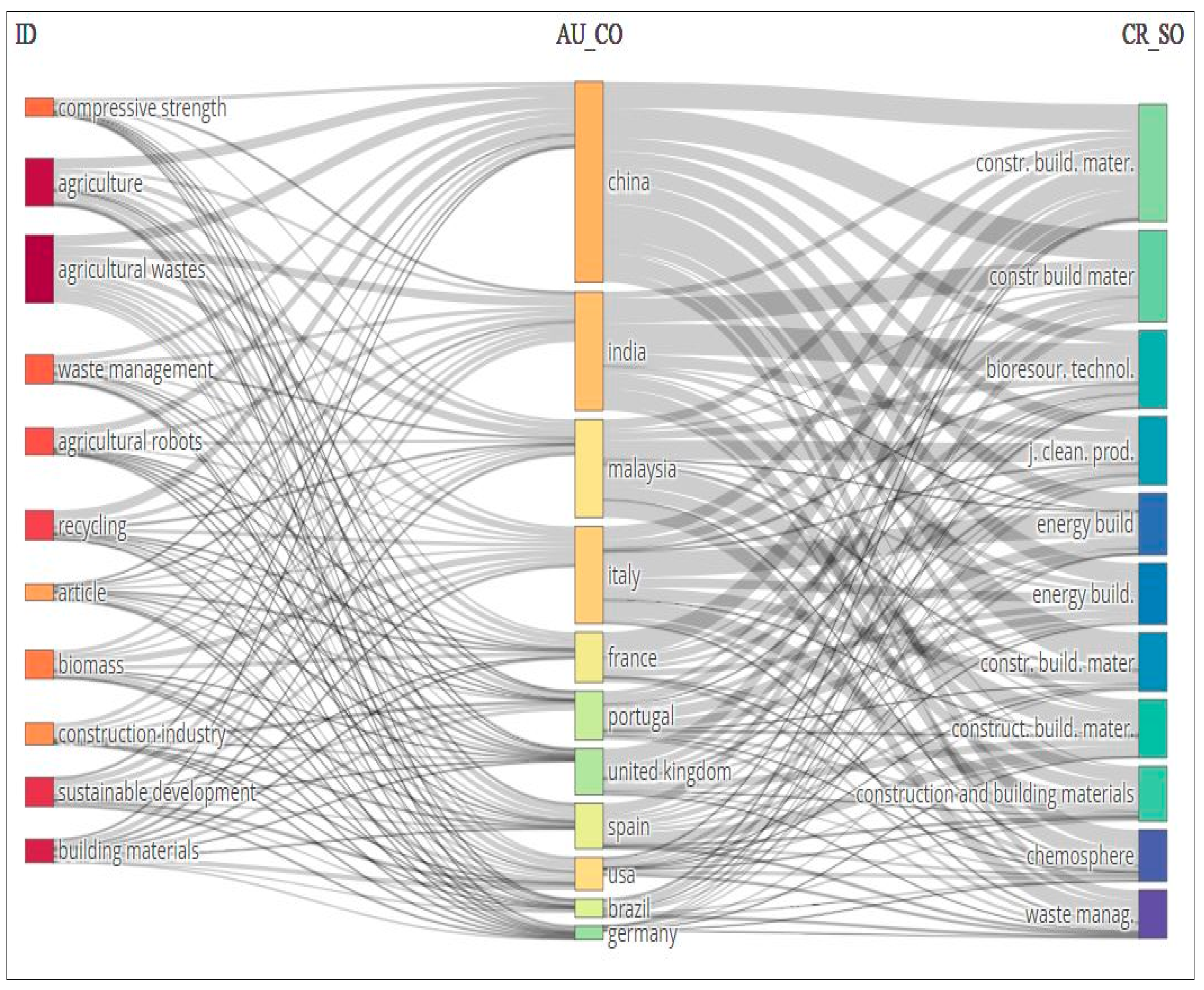
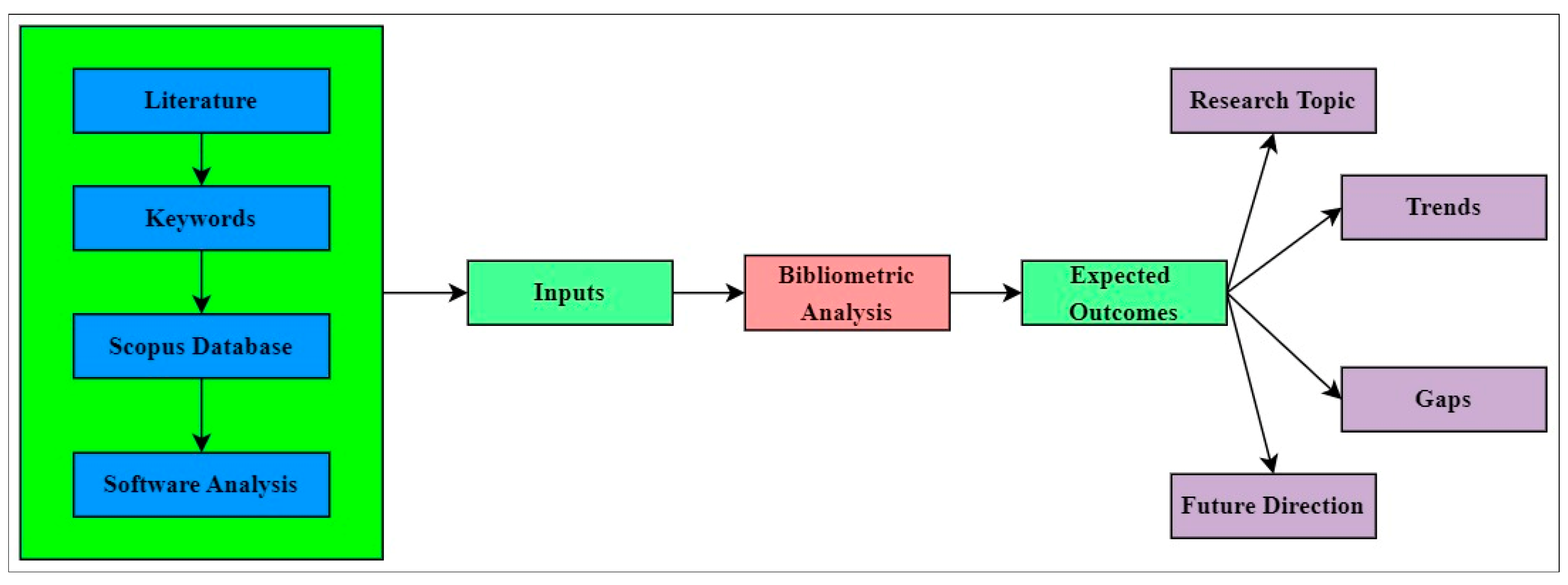
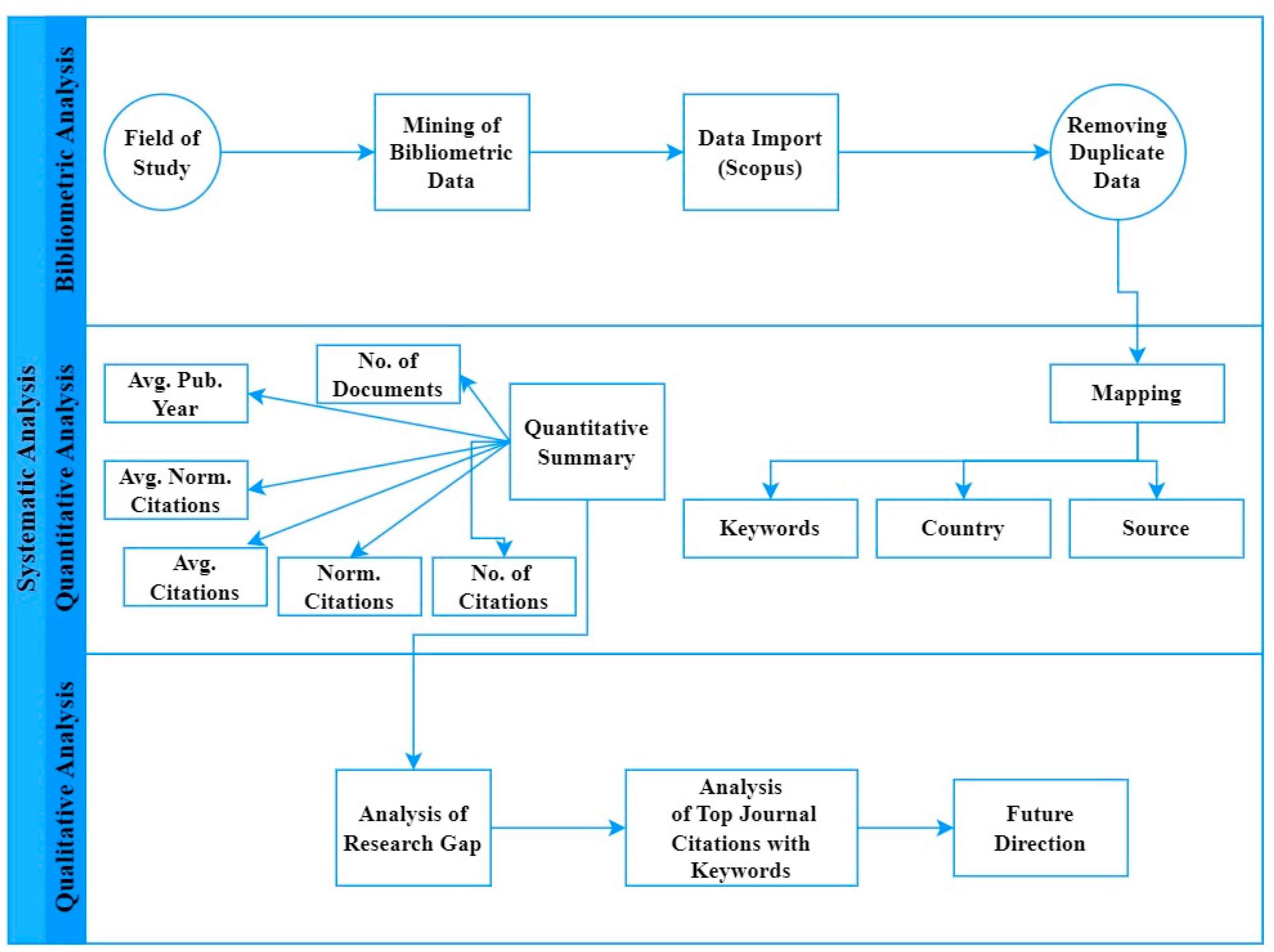


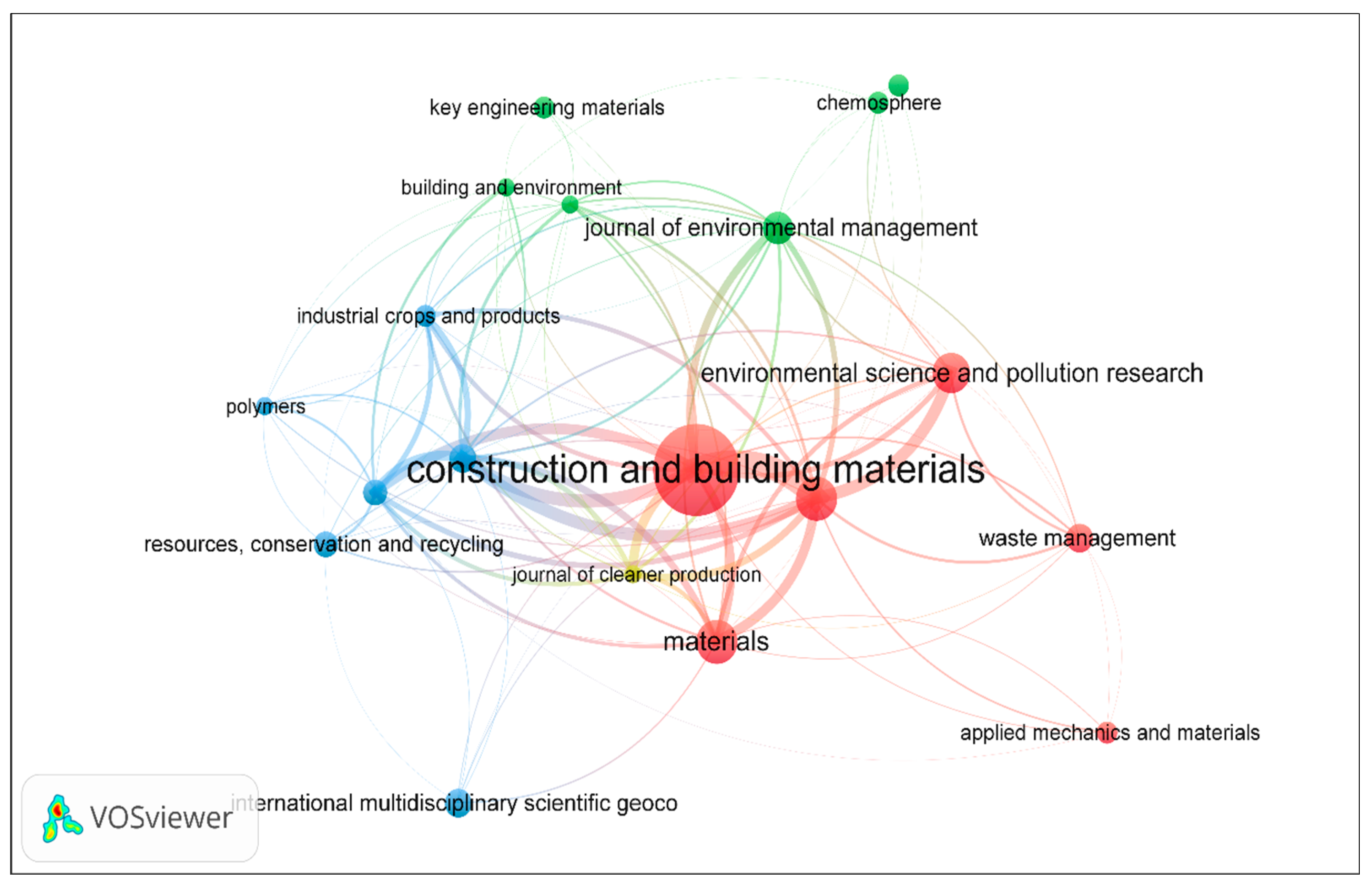




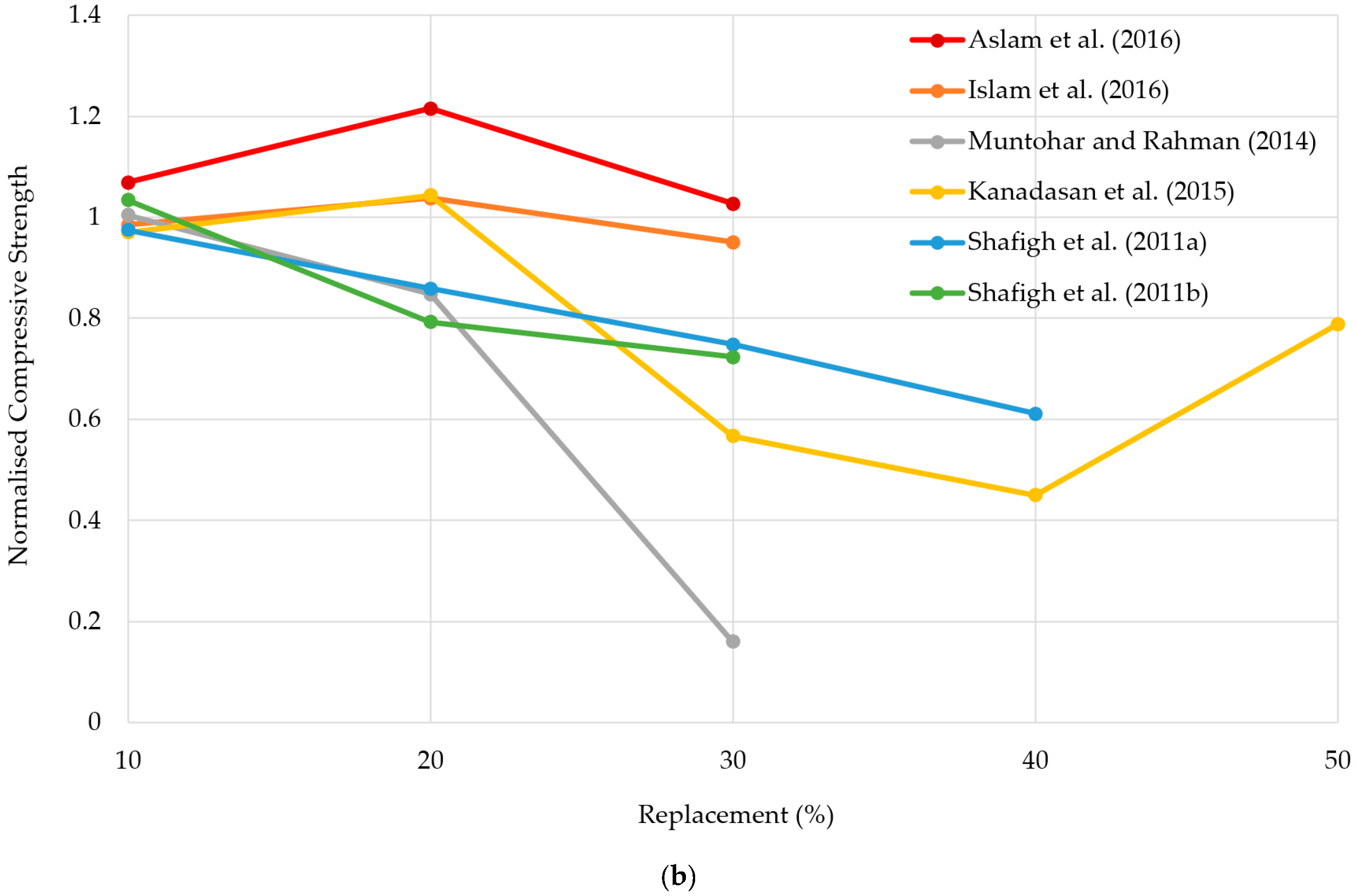
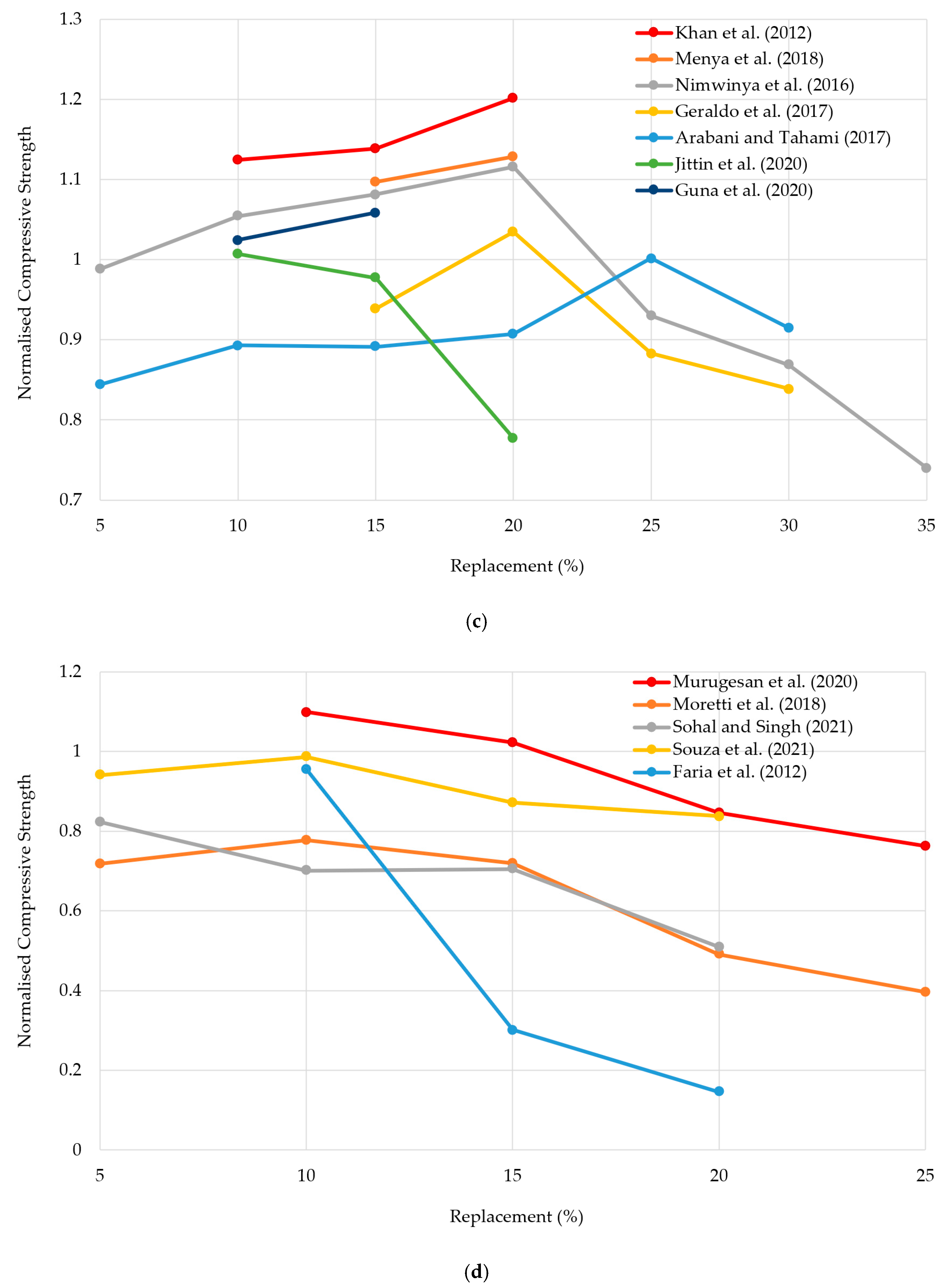
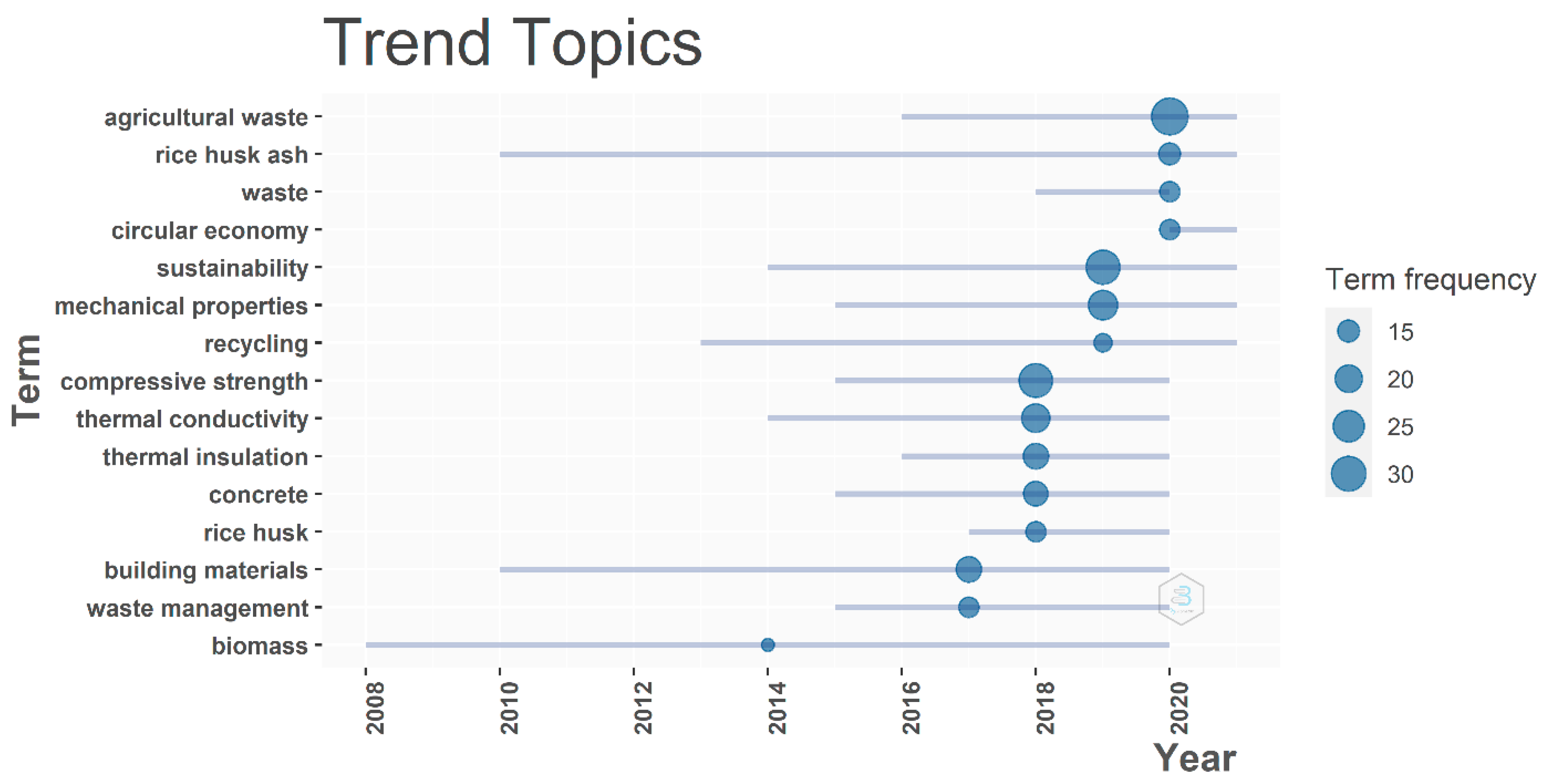
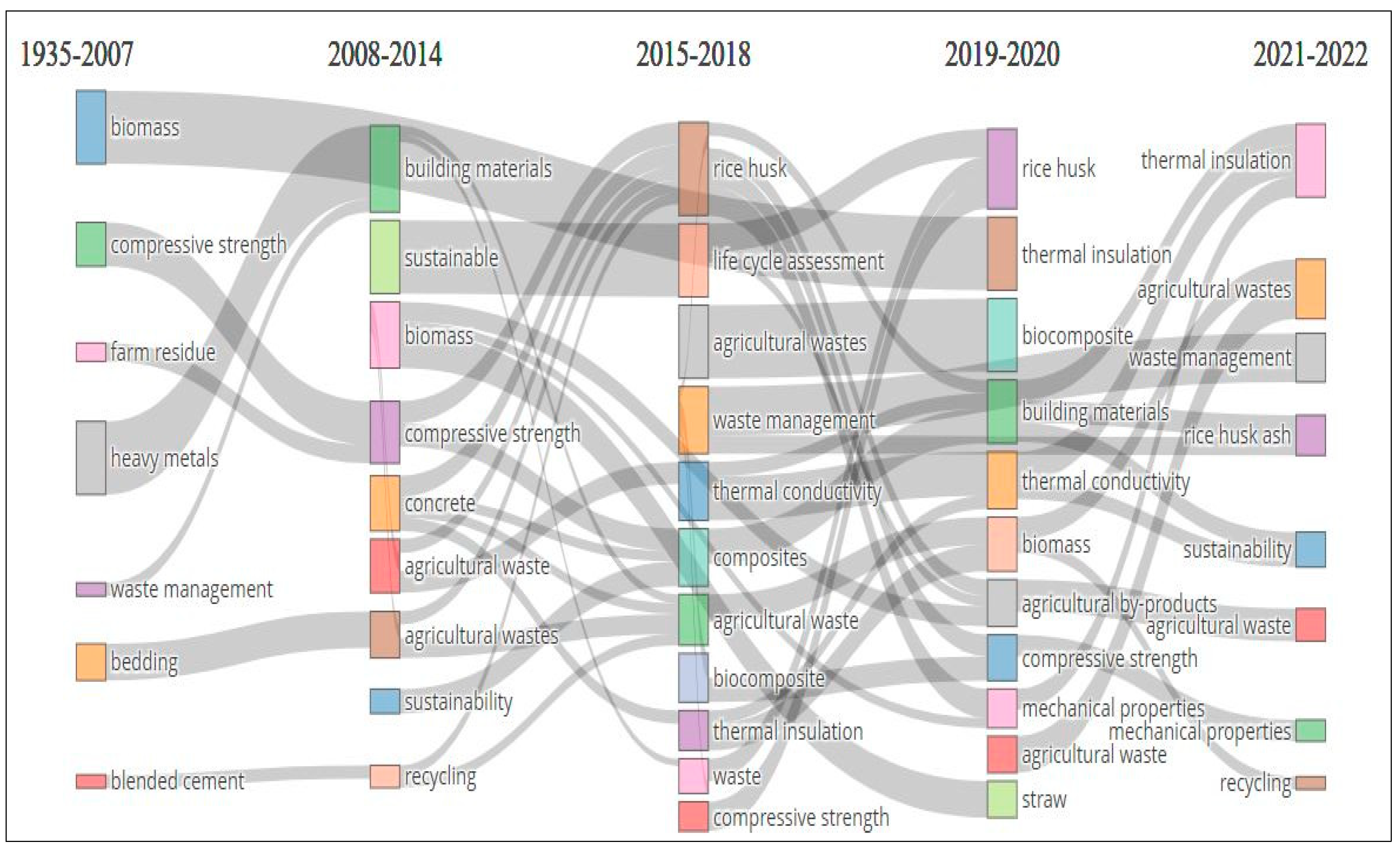
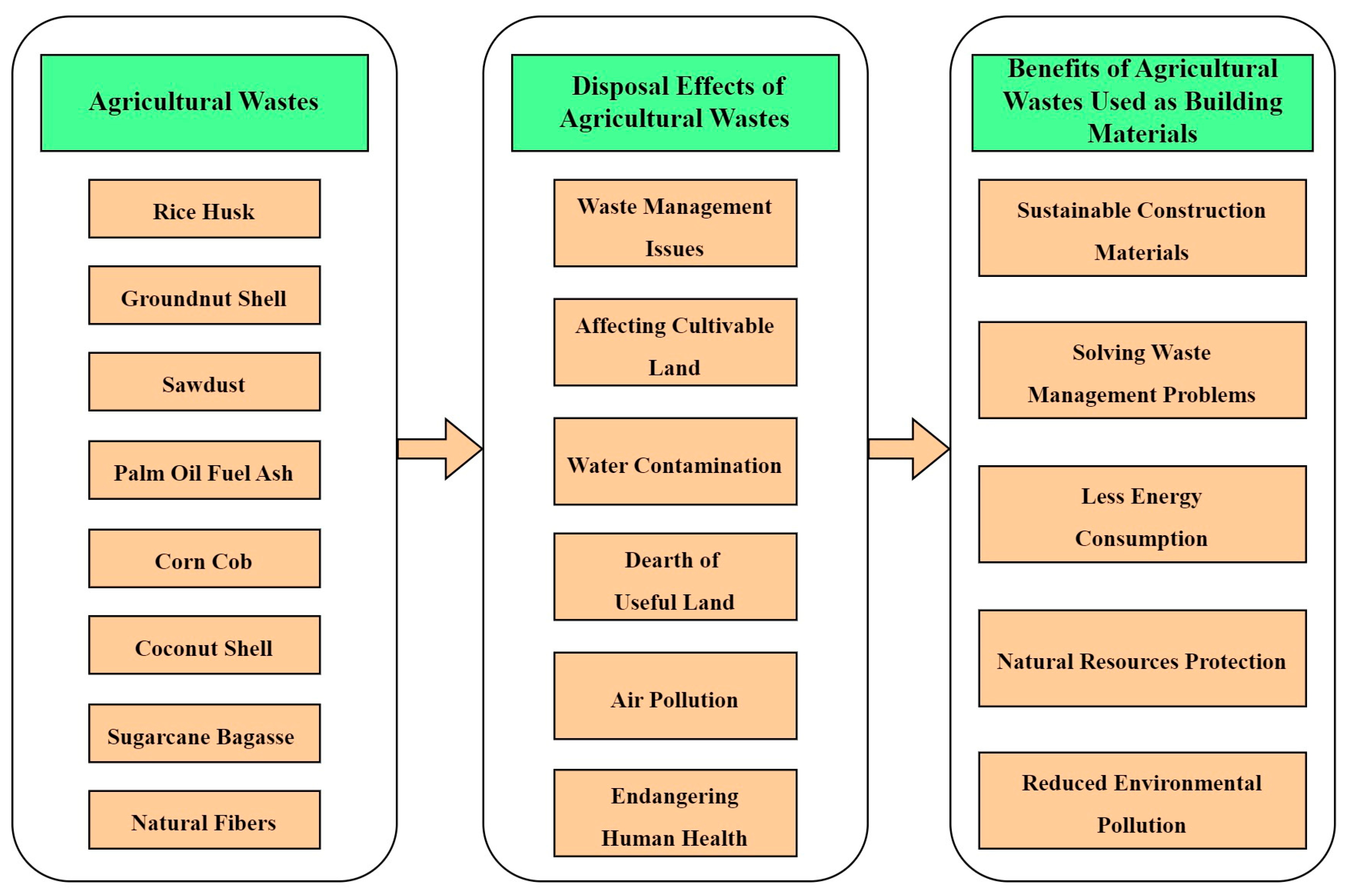
| Description | Results | Document Types | Results | Document Contents | Results |
|---|---|---|---|---|---|
| Time period | 1935–2022 | Short survey | 1 | Keywords Plus (ID) | 5404 |
| Article | 403 | Author’s Keywords (DE) | 1862 | ||
| Sources (journals, books, etc.) | 395 | Book | 3 | Authors | 2310 |
| Documents | 692 | Book chapter | 38 | Authors | 2580 |
| Average years from publication | 9.67 | Conference paper | 165 | Authors of single-authored documents | 87 |
| Average citations per document | 17.64 | Conference review | 21 | ||
| Average citations per year per document | 2.109 | Note | 1 | Authors of multi-authored documents | 2223 |
| Keywords | Occurrences | Avg. Pub. Year | Avg. Citation | Avg. Norm. Citation |
|---|---|---|---|---|
| Agricultural Wastes | 33 | 2018 | 12.42 | 1.11 |
| Sustainability | 29 | 2017 | 14.03 | 1.19 |
| Compressive Strength | 28 | 2014 | 20.79 | 1.18 |
| Mechanical Properties | 22 | 2018 | 16.45 | 1.42 |
| Thermal Conductivity | 21 | 2016 | 30.76 | 1.28 |
| Building Materials | 18 | 2015 | 15.56 | 0.94 |
| Thermal Insulation | 18 | 2017 | 21.72 | 1.52 |
| Concrete | 17 | 2017 | 10.94 | 1.06 |
| Rice Husk Ash | 15 | 2016 | 9.60 | 0.58 |
| Circular Economy | 14 | 2020 | 10.36 | 1.12 |
| Rice Husk | 14 | 2016 | 13.29 | 1.18 |
| Waste | 14 | 2018 | 26.71 | 2.60 |
| Waste Management | 14 | 2015 | 38.36 | 1.47 |
| Agricultural Wastes | 13 | 2015 | 5.08 | 0.57 |
| Fly Ash | 13 | 2016 | 33.15 | 0.88 |
| Recycling | 13 | 2017 | 48.69 | 1.53 |
| Biomass | 12 | 2013 | 36.42 | 1.27 |
| Source | Documents | Citations | Norm. Citations | Avg. Citations | Avg. Norm. Citations | Avg. Pub. Year |
|---|---|---|---|---|---|---|
| Construction and Building Materials | 25 | 893 | 55.46 | 35.72 | 2.22 | 2017 |
| Journal of Building Engineering | 12 | 89 | 17.87 | 7.42 | 1.49 | 2021 |
| Materials | 12 | 118 | 15.19 | 9.83 | 1.27 | 2020 |
| Environmental Science and Pollution Research | 11 | 523 | 21.74 | 47.55 | 1.98 | 2017 |
| Journal of Environmental Management | 9 | 257 | 14.36 | 28.56 | 1.60 | 2016 |
| Energy and Buildings | 8 | 184 | 11.81 | 23.00 | 1.48 | 2018 |
| International Multidisciplinary Scientific Geoconference Surveying Geology and Mining Ecology Management | 8 | 4 | 0.36 | 0.50 | 0.04 | 2016 |
| Waste Management | 8 | 486 | 22.08 | 60.75 | 2.76 | 2015 |
| Resources, Conservation and Recycling | 7 | 298 | 21.11 | 42.57 | 3.02 | 2017 |
| Sustainability (Switzerland) | 7 | 43 | 5.81 | 6.14 | 0.83 | 2020 |
| Applied Mechanics and Materials | 6 | 11 | 0.39 | 1.83 | 0.06 | 2013 |
| Chemosphere | 6 | 89 | 10.43 | 14.83 | 1.74 | 2020 |
| Industrial Crops and Products | 6 | 168 | 14.06 | 28.00 | 2.34 | 2019 |
| Key Engineering Materials | 6 | 26 | 0.95 | 4.33 | 0.16 | 2012 |
| Transactions of the Chinese Society of Agricultural Engineering | 6 | 14 | 1.13 | 2.33 | 0.19 | 2019 |
| Building and Environment | 5 | 629 | 12.02 | 125.80 | 2.40 | 2000 |
| Case Studies in Construction Materials | 5 | 104 | 7.74 | 20.80 | 1.55 | 2019 |
| Journal of Cleaner Production | 5 | 85 | 7.81 | 17.00 | 1.56 | 2018 |
| Polymers | 5 | 36 | 6.24 | 7.20 | 1.25 | 2020 |
| Country | Documents | Citations | Norm. Citations | Avg. Citations | Avg. Norm. Citations | Avg. Pub. Year |
|---|---|---|---|---|---|---|
| India | 79 | 1443 | 89.80 | 18.27 | 1.14 | 2011 |
| China | 62 | 1149 | 81.55 | 18.53 | 1.32 | 2018 |
| United States | 59 | 2183 | 96.16 | 37.00 | 1.63 | 2008 |
| Italy | 43 | 561 | 45.63 | 13.05 | 1.06 | 2018 |
| Malaysia | 35 | 451 | 37.04 | 12.89 | 1.06 | 2017 |
| Germany | 33 | 1642 | 53.34 | 49.76 | 1.62 | 2012 |
| United Kingdom | 32 | 1316 | 71.01 | 41.13 | 2.22 | 2013 |
| Spain | 29 | 372 | 25.98 | 12.83 | 0.90 | 2015 |
| Brazil | 23 | 471 | 52.10 | 20.48 | 2.27 | 2014 |
| France | 22 | 561 | 39.69 | 25.50 | 1.80 | 2016 |
| Turkey | 21 | 548 | 23.05 | 26.10 | 1.10 | 2013 |
| Russian Federation | 20 | 263 | 10.56 | 13.15 | 0.53 | 2016 |
| Thailand | 20 | 417 | 16.22 | 20.85 | 0.81 | 2014 |
| Year | Source | Article | TC | TC per Year | Norm. TC | Ref. |
|---|---|---|---|---|---|---|
| 2007 | Cement–Concrete Composites | “Evaluation of bagasse ash as supplementary cementitious material” | 403 | 25.19 | 6.42 | [66] |
| 2006 | Cement–Concrete Composites | “Strength development of concrete with rice-husk ash” | 258 | 15.18 | 4.31 | [67] |
| 1996 | Cement and Concrete Research | “Rice-husk ash paste and concrete: Some aspects of hydration and the microstructure of the interfacial zone between the aggregate and paste” | 217 | 8.04 | 1.00 | [68] |
| 2015 | Construction and Building Materials | “Supplementary cementitious materials origin from agricultural wastes—A review” | 209 | 26.13 | 7.85 | [69] |
| 2011 | Construction and Building Materials | “The study of using rice husk ash to produce ultra-high performance concrete” | 198 | 16.50 | 5.33 | [70] |
| 2006 | Construction and Building Materials | “A huge number of artificial waste material can be supplementary cementitious material (SCM) for concrete production—A review part II” | 194 | 11.41 | 3.24 | [71] |
| 2017 | Journal of Cleaner Production | “Sugarcane bagasse—The future composite material: A literature review” | 186 | 31.00 | 16.23 | [72] |
| 2013 | Resources, Conservation and Recycling | “Concrete from an agricultural waste-oil palm shell (OPS)” | 173 | 17.30 | 9.75 | [73] |
| 1984 | International Journal of Cement Composites and Lightweight Concrete | “Use of rice husk ash in concrete” | 138 | 3.54 | 7.26 | [74] |
| 1990 | Journal of Materials in Civil Engineering | “Ash from oil-palm waste as a concrete material” | 135 | 4.09 | 2.00 | [75] |
| Year | Source | Article | TC | TC per Year | Norm. TC | Ref. |
|---|---|---|---|---|---|---|
| 2016 | Renewable Sustainable Energy Review | “Potential applications of rice husk ash waste from rice husk biomass power plant” | 358 | 51.14 | 6.40 | [80] |
| 1995 | Applied Clay Science | “Clay and man: clay raw materials in the service of man” | 257 | 9.18 | 1.00 | [81] |
| 2003 | Building and Environment | “New insulating particle boards from durian peel and coconut coir” | 198 | 9.90 | 2.00 | [82] |
| 2008 | Waste Management | “Effect of organic residues addition on the technological properties of clay bricks” | 192 | 12.80 | 3.80 | [83] |
| 2005 | Building and Environment | “Utilization of kraft pulp production residues in clay brick production” | 150 | 8.33 | 1.86 | [84] |
| 1992 | Bioresource Technology | “Mechanical and thermal properties of particle boards made from farm residues” | 103 | 3.32 | 1.28 | [85] |
| 2004 | Bioresource Technology | “Possibility of using waste tire composites reinforced with rice straw as construction materials” | 101 | 5.32 | 2.00 | [86] |
| 2017 | Renewable Sustainable Energy Review | “The development history and prospects of biomass-based insulation materials for buildings” | 94 | 15.67 | 6.65 | [78] |
| 1992 | Biomass Bioenergy | “Physical and chemical properties of soils as affected by municipal solid waste compost application” | 91 | 2.94 | 1.13 | [87] |
| 2012 | Construction and Building Materials | “Characterization of corn cob as a possible raw building material” | 90 | 8.18 | 1.84 | [88] |
| Agricultural Wastes | Density (kg/m3) | Thickness (mm) | Water Absorption (%) | Thermal Conductivity (W/mK) |
|---|---|---|---|---|
| Cotton stalk | 150–450 | 25 | 13 | 0.0585–0.0815 |
| Banana bunch | 1000 | 3 | – | N.A. |
| TPM/corn peel | 789 ± 16 | 3.5 | 52.3 ± 3.2 | 0.147 ± 0.0082 |
| Coconut coir | 311–856 | 10 | 227.382–32.291 | 0.0764–0.1254 |
| Maize husk | 310 | 16 | 11–14 | 0.000348 |
| Paddy straw | 190 | 16 | 11–14 | 0.000229 |
| Coconut pith | 290 | 16 | 11–14 | 0.000314 |
| Groundnut shell | 540 | 16 | 11–14 | 0.000548 |
| Kenaf board | 150–200 | – | – | 0.051–0.058 |
| Year | Source | Article | TC | TC per Year | Norm. TC | Ref. |
|---|---|---|---|---|---|---|
| 2007 | Cement–Concrete Composites | “Evaluation of bagasse ash as supplementary cementitious material” | 403 | 25.19 | 2.81 | [66] |
| 2016 | Construction and Building Materials | “RETRACTED: Microstructure and durability properties of cement mortars containing nano-TiO2 and rice husk ash” | 129 | 18.43 | 2.98 | [93] |
| 2012 | Construction and Building Materials | “Reduction in environmental problems using rice-husk ash in concrete” | 114 | 10.36 | 3.70 | [94] |
| 2016 | Construction and Building Materials | “Influence of different curing temperatures and alkali activators on properties of GBFS geopolymer mortars containing fly ash and palm-oil fuel ash” | 105 | 15.00 | 2.42 | [95] |
| 1990 | Cement and Concrete Research | “Incineration of rice hull for use as a cementitious material: the Guyana experience” | 100 | 3.03 | 1.00 | [96] |
| 2016 | International Journal of Environment and Sustainable Development | “Concrete using agro-waste as fine aggregate for sustainable built environment—A review” | 95 | 13.57 | 2.19 | [9] |
| 2015 | Construction and Building Materials | “Properties of natural fiber cement materials containing coconut coir and oil palm fibers for residential building applications” | 93 | 11.63 | 2.62 | [97] |
| 1986 | Cement and Concrete Research | “Reactivity of rice husk ash” | 93 | 2.51 | 1.00 | [98] |
| 2016 | Construction and Building Materials | “RETRACTED: Polypropylene fiber reinforced cement mortars containing rice husk ash and nano-alumina” | 91 | 13.00 | 2.10 | [99] |
| 2015 | Ceramics International | “Mechanical and durability properties of alkali-activated mortar based on sugarcane bagasse ash and blast furnace slag” | 63 | 7.88 | 1.77 | [100] |
| Chemical Composition | OPC (%) | CCA (%) | POFA (%) | RHA (%) | SCBA (%) | GNSA (%) |
|---|---|---|---|---|---|---|
| SiO2 | 17.6 | 67.33 | 64.17 | 92.95 | 75.67 | 26.96 |
| Al2O3 | 4.02 | 7.34 | 3.73 | 0.31 | 1.52 | 5.82 |
| Fe2O3 | 4.47 | 3.74 | 6.33 | 0.26 | 2.29 | 0.5 |
| CaO | 67.43 | 10.29 | 5.8 | 0.53 | 6.62 | 9.5 |
| MgO | 1.33 | 1.82 | 4.87 | 0.55 | 1.87 | 5.6 |
| SO3 | 4.18 | 1.11 | 0.72 | − | − | 1.86 |
| Na2O | 0.03 | 0.39 | 0.18 | 0.08 | 0.12 | 1.15 |
| K2O | 0.39 | 4.2 | 8.25 | 2.06 | 9.59 | 20.02 |
| P2O5 | − | − | − | 2 | ||
| MnO2 | − | − | − | 0.32 | ||
| TiO2 | − | − | − | 0.69 |
Disclaimer/Publisher’s Note: The statements, opinions and data contained in all publications are solely those of the individual author(s) and contributor(s) and not of MDPI and/or the editor(s). MDPI and/or the editor(s) disclaim responsibility for any injury to people or property resulting from any ideas, methods, instructions or products referred to in the content. |
© 2023 by the authors. Licensee MDPI, Basel, Switzerland. This article is an open access article distributed under the terms and conditions of the Creative Commons Attribution (CC BY) license (https://creativecommons.org/licenses/by/4.0/).
Share and Cite
Ganasen, N.; Bahrami, A.; Loganathan, K. A Scientometric Analysis Review on Agricultural Wastes Used as Building Materials. Buildings 2023, 13, 426. https://doi.org/10.3390/buildings13020426
Ganasen N, Bahrami A, Loganathan K. A Scientometric Analysis Review on Agricultural Wastes Used as Building Materials. Buildings. 2023; 13(2):426. https://doi.org/10.3390/buildings13020426
Chicago/Turabian StyleGanasen, Nakkeeran, Alireza Bahrami, and Krishnaraj Loganathan. 2023. "A Scientometric Analysis Review on Agricultural Wastes Used as Building Materials" Buildings 13, no. 2: 426. https://doi.org/10.3390/buildings13020426
APA StyleGanasen, N., Bahrami, A., & Loganathan, K. (2023). A Scientometric Analysis Review on Agricultural Wastes Used as Building Materials. Buildings, 13(2), 426. https://doi.org/10.3390/buildings13020426








